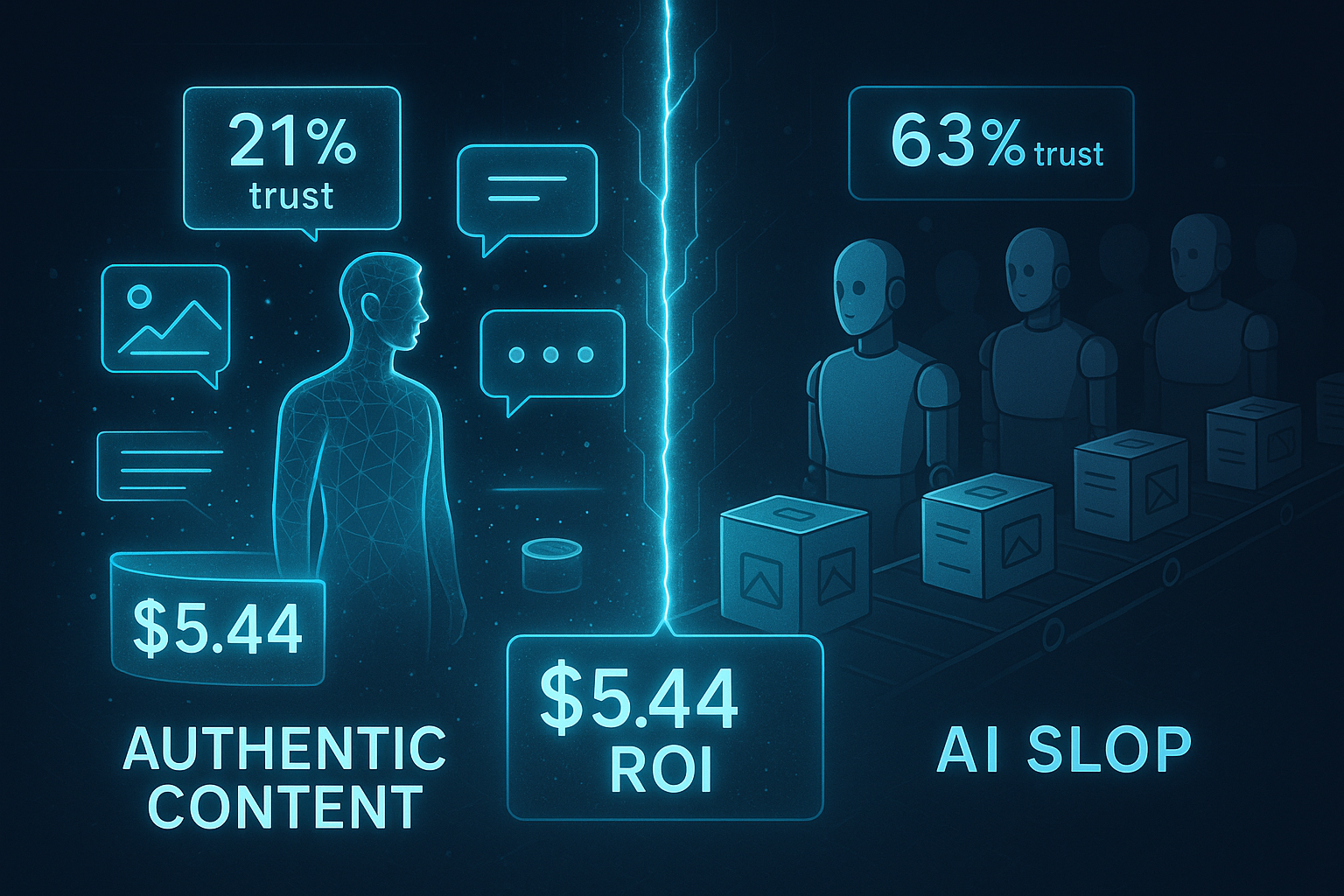
The $6.65 Billion Problem: Why Automation Content Marketing Is Failing
The $6.65 billion automation content marketing industry has a dirty secret that's costing brands their credibility. Most automation creates what I like to call "AI slop" - generic, templated content that kills the very thing marketing is supposed to build: trust.
I learned this lesson the hard way back when I was managing millions in ad spend and analyzing over a thousand sales funnels at ClickFunnels. The funnels that converted best weren't the slickest or most polished. They were the ones where you could feel the founder's personality coming through every single page. They told stories. They shared real experiences. They built that critical know, like, and trust factor that Bob Burg talks about when he says "People do business with those they know, like, and trust."
Here's the thing that most people miss: only 21% of consumers trust obviously generic, templated content compared to 63% who trust authentic brand content. That's a trust gap that can make or break your business. But here's what gets me excited - companies using authentic automation see $5.44 return for every $1 spent, with personalized content yielding 34% higher click-through rates.
So let me show you how to automate content creation that AMPLIFIES your expertise instead of replacing it.
The Hidden Cost of AI Slop in Content Marketing
If you think that you've "solved" your content problem by having AI write everything, think again. It may only take 6 months before your organic traffic and engagement tank, and worst of all, completely lose your brand voice.
This is what is now called "AI slop," and it's everywhere. AI slop is generic, soulless content that lacks personality and is obviously written by an LLM. It's content that fails the "authenticity test." It has no brand voice, no personal experience, no unique insights. It's the opposite of building "know, like, and trust."
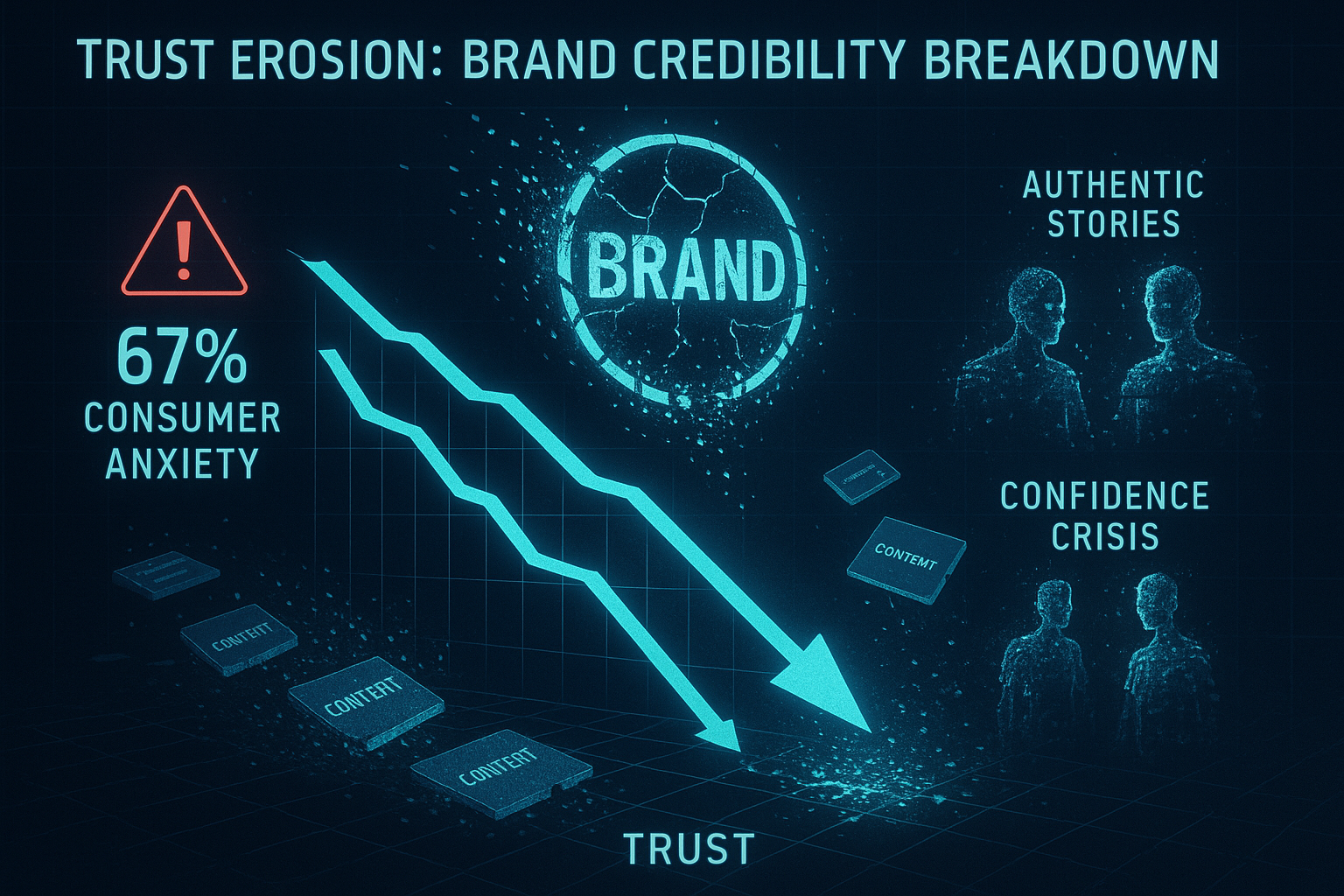
Why AI Slop Kills Your Marketing
The numbers don't lie. Google's March 2024 "Helpful Content Update" introduced penalties for what they call "scaled content abuse." Sites publishing generic AI content saw 30%+ traffic drops overnight. But the algorithm isn't the only thing working against you.
Think about it from your audience's perspective. Research shows that 67% of consumers harbor anxiety about AI-driven marketing content. When people can tell your content is just regurgitated AI output, they lose trust in your brand. They start questioning whether you actually know what you're talking about.
I saw this firsthand with CNET in 2023. They published unedited AI finance articles with factual errors, and the backlash was swift. They lost trust, lost rankings, and had to completely revise their content strategy. The lesson? When you remove the human expertise and oversight, you're playing with fire.
The Trust Factor Problem
This reminds me of something I learned during my law school days before I pivoted into marketing. In law, authenticity isn't just nice to have - it's everything. Judges and juries can spot a fake argument from a mile away. The same principle applies to content marketing.
Research by Hollebeek and Macky shows that authenticity is foundational for the "know, like, trust" progression in digital content marketing. When your content lacks that authentic voice, you're not just failing to build trust - you're actively eroding it.The psychological impact is real. When people consume generic content, they experience what researchers call a "confidence crisis." They start questioning not just the content, but the brand behind it. And once that trust is broken, it's incredibly difficult to rebuild.
The AMPLIFY Framework for Authentic Content Automation
After years of testing different approaches and seeing what actually works, I developed what I call the AMPLIFY framework. This isn't theory - it's based on real results from companies like Unilever, The Washington Post, and my own clients.
As Kaltura's 2025 Marketing Guide puts it: "A human still has to create all the content. The real magic happens when these two tools [AI and automation] are combined...AI can use engagement data and natural language processing to find the most impactful moments...makes sense and resonates with your audience."
Let me break down each component:
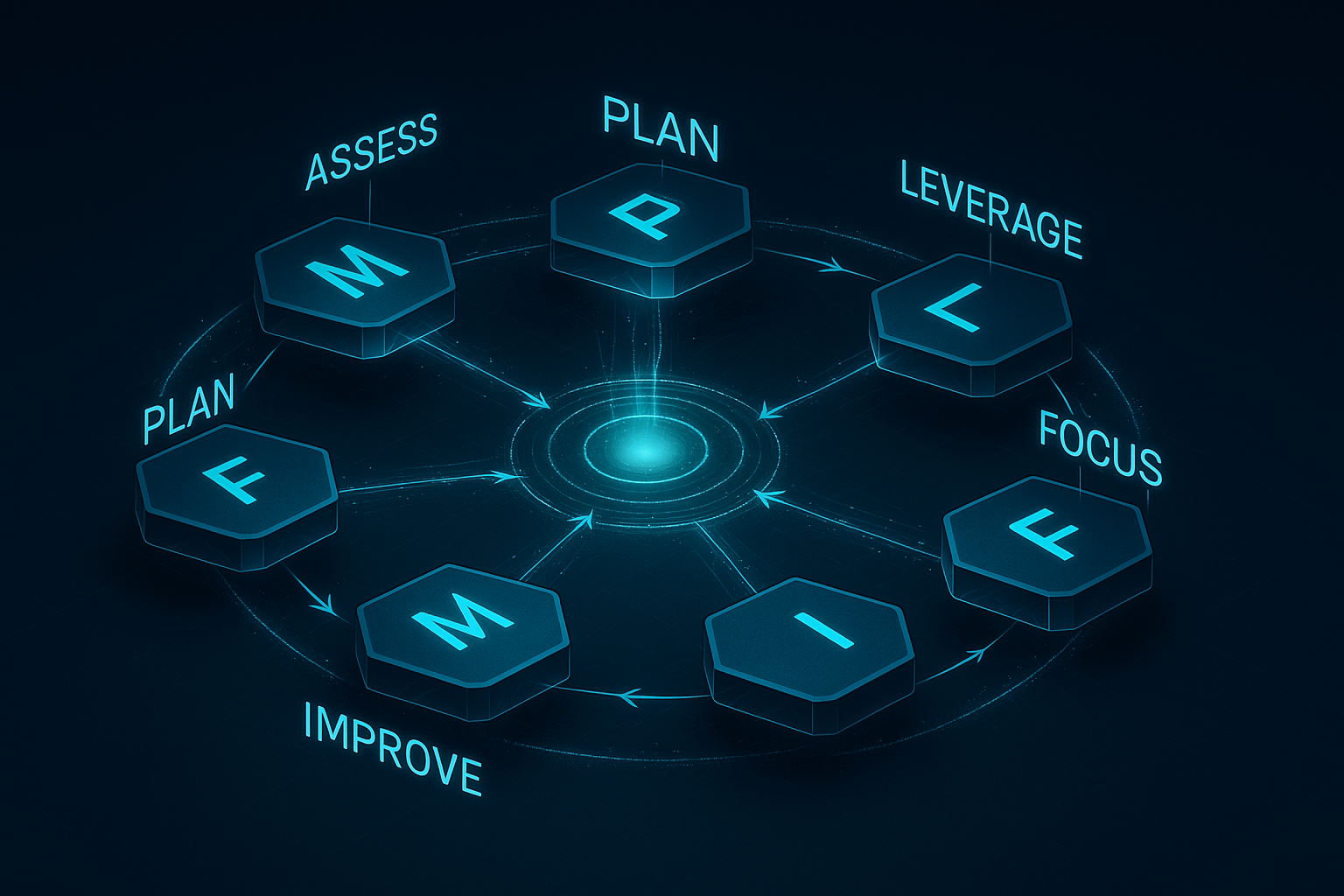
A - Archive Your Expertise
This is where most people go wrong. They jump straight into AI tools without building what I call their "external brain" - a repository of their unique expertise, stories, and insights.
Think about it this way: when I was analyzing those thousand-plus funnels at ClickFunnels, I wasn't just looking at conversion rates. I was studying the stories that worked, the hooks that grabbed attention, the frameworks that built trust. All of that experience became part of my "external brain."
You need to document:
- Your personal origin stories (like my pivot from law to marketing)
- Client transformation cases (like how I doubled the conversion rate of a funnel that generated an additional $1 million for a client)
- Your proprietary frameworks and methodologies (Like this AMPLIFY framework)
- Lessons learned from failures
- Your core values and beliefs
Companies like Unilever's U-Studio successfully combine AI insights with this kind of human expertise repository to maintain authenticity at scale.
M - Maintain Your Voice
Here's where I see a lot of automation go wrong. People feed generic prompts into AI and wonder why their content sounds like everyone else's.
Your voice is your competitive advantage. When I create content, whether it's a YouTube video or a blog post, I'm not trying to sound like every other marketing expert. I talk about my law school days. I start with "Hey there." I share specific stories from my ClickFunnels days or talk about managing millions in ad spend.
The Washington Post's Heliograf achieved 17% higher click-through rates because they maintained editorial standards in their automated content. They didn't just set it and forget it - they preserved what made their content uniquely theirs.P - Personalize at Scale
This is where the magic happens. Once you've got your repository built and your voice guidelines established, you can use AI to create personalized content that still feels authentically you.
Shapeways achieved a 238% increase in open rates and 525% increase in click-through rates through personalized automation. But the key is that they used their expertise to inform the personalization, not just demographic data.When you personalize with authentic insights rather than just "Dear [First Name]" tokens, you hit that sweet spot of 34% higher click-through rates and 2.8x longer time on page.
L - Leverage Strategic Systems
The technology is just a tool. I learned this lesson back when I was working in tax resolution and then pivoted to marketing. We had a lot of tools to assist with our clients' tax problems. However, the tools themselves don't create success. It's how you use them strategically that does.
77% of marketers now use automation content marketing tools for personalized content creation, but the successful ones all have one thing in common: they maintain human oversight and strategic thinking.Your systems need to support your expertise, not replace it. Distribution automation, workflow automation, analytics automation - all of it should amplify what makes you unique, not standardize it.
I - Integrate Human Oversight
This is non-negotiable. Every single successful case study I've analyzed - from Unilever to The Washington Post to my own client work - maintained human editorial review.
As John Barrows from JB Sales puts it: "Turn your sales org into a sales lab... experiment until they find the applications they love." The key word there is "they" - humans are still driving the process.
You need quality control checkpoints based on trust psychology research. You need to know when to add manual touches versus automated efficiency. And you need to be constantly monitoring for that authenticity that builds real relationships.
F - Focus on Relationship Building
This takes me back to my healthcare marketing days. One quarter, my team helped generate $1 million in new patient sales for a client, but it wasn't because of the ad creative or the targeting. It was because we built a system that made each potential patient feel known and cared for.
Content designed specifically to build know, like, trust progression performs differently than content designed just to convert. When you automate storytelling while maintaining emotional connection, you're building assets that compound over time.
Y - Yield Measurable Trust
Here's where most marketers are measuring the wrong things. They're looking at clicks and impressions instead of trust indicators and relationship depth.
The average $5.44 return for every $1 spent on authentic automation content marketing doesn't come from gaming metrics - it comes from building genuine relationships that turn into long-term business value. Book More Brides achieved 2,375% email growth and nearly $1 million in recurring sales because they focused on trust-building automation, not just list building.
Building Your Content Repository (Your "External Brain")
Let me share how I built my own repository, because this is where the real magic happens.
After I made that difficult decision to completely change direction from law to marketing, I started documenting everything. Not just the wins, but the failures too. Like the time I spent 30 days in the ICU next to my mom, which completely changed my perspective on work-life balance and led me to quit my 9-to-5.
These aren't just personal stories. They're the foundation of authentic content. When AI draws from these experiences, it creates content that could only come from me.
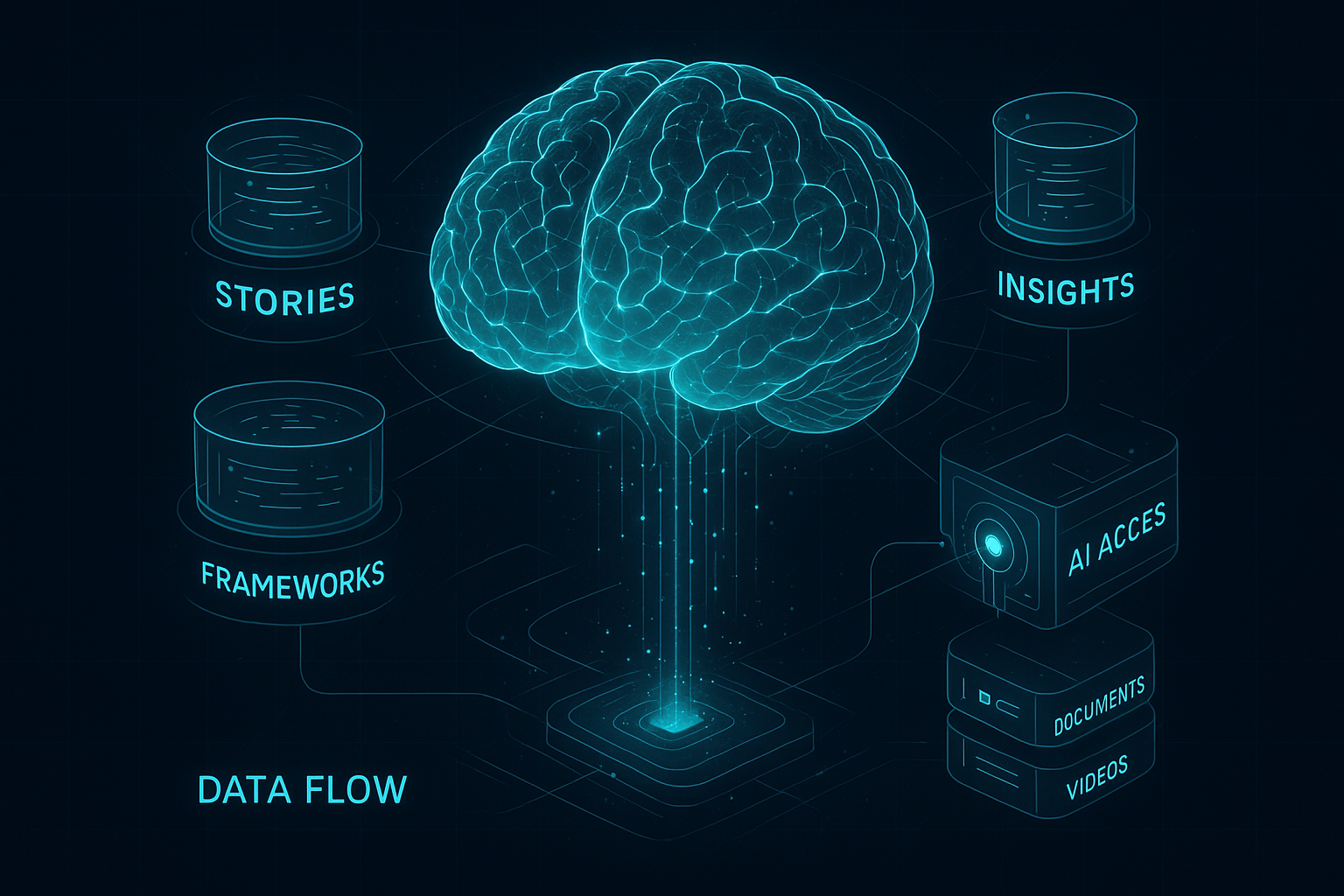
Essential Elements to Document
Start with your origin story. Mine involves law school, tax resolution, my mom's illness, and that pivotal moment when I decided to chase my passion for marketing (and later software development on top) instead of playing it safe and leaning into tax law. What's yours?
Then document your client transformation stories. That healthcare client who went from struggling to $1M in new patient sales in one quarter? I can tell that story in detail because I lived it. I know the exact hook we used, the automation sequence we built, the offer that converted.
Don't forget your industry insights and predictions. After analyzing over a thousand sales funnels, I developed frameworks that only someone with that specific experience could create. Those insights become content gold when properly archived.
Organization Systems
This isn't just about collecting stories - it's about making them accessible to AI systems. I use tagging and categorization strategies that make my content easily searchable. When I need content about client results, I can pull up specific case studies. When I need personal motivation content, I can access those transformation stories.
Version control matters too. My stories evolve as I gain perspective and new experiences. The story of leaving law for marketing hits differently now than it did 7 years ago, and both versions have value for different contexts.
Automation Tools and Workflows That Preserve Authenticity
The marketing automation tools are evolving fast, but the principles remain constant. I've tested dozens of AI writing tools, and the ones that work best are those that can access your custom repository while maintaining your voice guidelines. On top of accessing these repositories, the optimal workflow would also interview you and extract additional insights from you based on the subject of the article itself. This is optimally done with tools like Claude Code that you can use to create a repository of your website and train all of the specialized subagents of the workflow. For a detailed step-by-step implementation of this AI SEO research workflow, see my comprehensive AI SEO research guide. A tool like n8n can also do it if you prefer a more user friendly UI. Or the easiest way is to use a tool like Claude Projects or ChatGPT Projects and give it clear instructions of a workflow to follow (This is less customizable, but it's the lowest barrier to entry to get started.)
Content Creation Automation
The key is prompt engineering that draws from your authentic experiences. Instead of generic prompts like "write about automated marketing campaigns," you can use prompts like "write about marketing automation strategy using the story of how I generated $1M for a healthcare client, maintaining my conversational tone and including specific tactical details. Here is where you have access to all of the necessary context..."
Quality control workflows are essential. Every piece of automated content goes through my authenticity filter: Could this have been written by someone else? Does it include unique perspective? Does it maintain my voice?
Performance Tracking Automation
This is where most people measure the wrong things. Instead of just tracking opens and clicks, I track engagement quality. How long are people spending with my content? Are they sharing it? Do they click on a CTA? For your website, you can set up all of this using the Funnels feature in Google Analytics after setting up your custom events. For a deeper analysis of SEO's overall value proposition and ROI in the AI era, read my comprehensive analysis on whether SEO is still worth it in 2025. (Oh and by the way, if you need help setting any of this up, feel free to set up a call below and we could see if we could help or at least point you in the right direction.)
Trust-building indicators matter more than vanity metrics. A smaller, more engaged audience that trusts your expertise is infinitely more valuable than a large audience that sees you as just another content creator.
Case Studies: Brands Doing Automation Content Marketing Right
Let me walk you through some real examples of companies that are getting this right, because the patterns are incredibly instructive.

The Washington Post - Heliograf
The challenge was scaling hyperlocal and niche content production without sacrificing the journalistic quality that built their reputation. Their solution wasn't to replace reporters with AI - it was to augment their capabilities.
They created AI automation with human editorial oversight, used personalized push notifications based on AI insights, and maintained journalistic standards throughout the automation process.
The results speak for themselves: 850+ articles in the first year, 17% higher click-through rates on personalized notifications, 2x more views on AI-distributed content, and 1.5x longer average reading time.
The key success factors? Editorial review, transparency about AI use, and focus on reader value. They never forgot that the technology serves the mission, not the other way around.
Shapeways - B2B Manufacturing
This is a great example because B2B automation is tricky. Technical audiences are skeptical of generic content, and rightfully so. Shapeways needed to improve email marketing performance in a technical market where expertise really matters.
Their implementation focused on personalized email automation via Mailchimp, but the magic was in the segmentation based on customer behavior and technical needs. They maintained human oversight for technical accuracy because they knew their audience would spot mistakes immediately.
Results: 238% increase in email open rates and 525% increase in click-through rates. More importantly, they saw significant improvement in lead quality and sales conversion because the personalization was based on genuine understanding of customer needs.
Book More Brides - B2B Services
This case study is particularly interesting because it shows how authenticity scales in relationship-based businesses. The challenge was scaling a membership business while maintaining the personal touch that made it successful in the first place.
They used Ontraport automation system with personalized nurture sequences, but the secret sauce was authentic storytelling in automated emails. Every automated touchpoint felt like it came from the founder because it drew from her actual experiences and expertise.
The results were extraordinary: 2,375% email list growth and nearly $1 million in sales from recurring memberships. Strong customer retention and community building proved that automation enhanced rather than replaced the relationship-building that drives this type of business.
When Automation Goes Wrong: CNET's Cautionary Tale
Not every automation story has a happy ending. CNET's 2023 AI content experiment is a perfect example of what happens when you remove human expertise from the equation.
They published unedited AI-generated finance articles with factual inaccuracies, lack of transparency about AI authorship, no human editorial review process, and generic content that lacked the expertise their audience expected.
The consequences were swift and severe: public backlash, trust erosion, Google ranking penalties, and a complete revision of their AI content strategy that required implementing human editorial review.
The lessons are clear: transparency, human oversight, and expertise integration aren't nice-to-haves. They're non-negotiable for sustainable content automation.
Your 90-Day Implementation Roadmap
As Anita Nielsen from LDK Advisory Services puts it: "The benefits come when we see AI as a tool, not a terror, and bring it into our sales motions." Here's how to make that happen strategically.
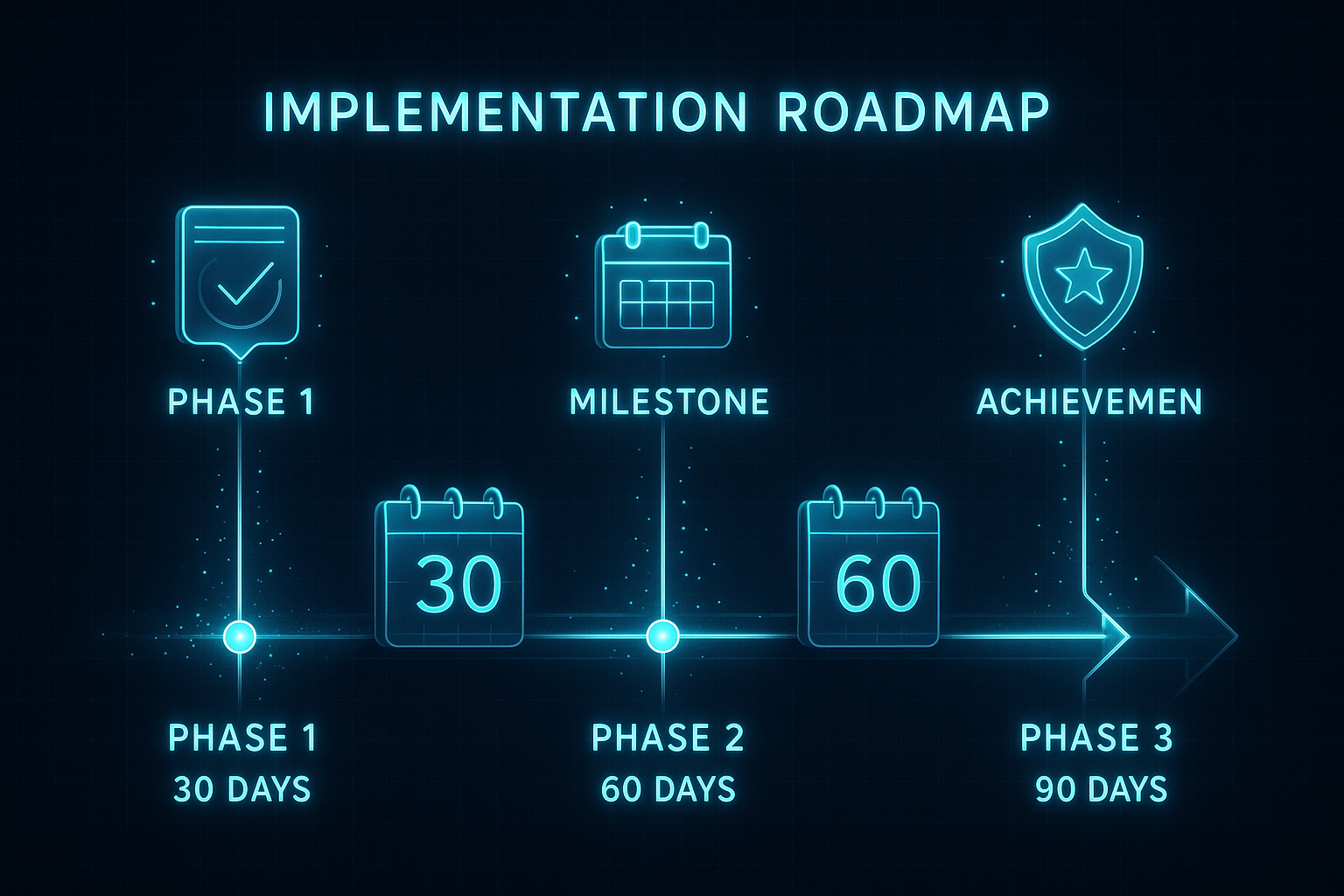
Days 1-30: Foundation Building
Start by auditing your existing content. Which pieces pass the "authenticity test"? Which ones feel generic and could have been written by anyone? This baseline is crucial for measuring improvement.
I remember doing this exercise for my own content and being shocked at how much of it could have come from any marketing expert. The pieces that performed best were always the ones with specific stories, unique frameworks, or personal insights.
Week 2-3: Build Your Content RepositoryThis is where the real work begins. Start documenting your personal origin stories, client transformation cases, and proprietary frameworks. Think of this as creating your "external brain" following the successful models like Unilever's U-Studio approach.
Companies with well-documented expertise repositories show 26-40% higher engagement, but more importantly, they maintain authenticity at scale.
Week 4: Voice and Brand GuidelinesDefine your voice guidelines informed by consumer psychology research. Create authenticity checkpoints based on the "know, like, trust" framework. All the successful case studies maintained strict voice consistency, and this is where that discipline starts.
Days 31-60: System Setup
Choose content automation platforms that support human oversight integration. 77% of marketers use AI-powered automation, but the successful ones select tools that allow personal input rather than just generic output.
Configure your systems for personalization at scale following the Shapeways success model. The technology should amplify your expertise, not replace it.
Week 7: Content Workflow DevelopmentCreate workflows that preserve authenticity like The Washington Post's Heliograf. Establish human review checkpoints at critical decision points. Remember the key principle: "A human still has to create all the content" - ensure editorial oversight throughout.
Week 8: Quality Control ProcessesImplement trust-building quality controls based on the academic research we discussed. Create approval processes that prevent AI slop from reaching your audience. Learn from CNET's failure - no content should be published without human review.
Days 61-90: Scale and Optimize
Begin with low-risk content types while maintaining high oversight. Target those performance metrics we discussed - aim for 34% higher click-through rates for personalized content versus generic alternatives.
Monitor for authenticity maintenance throughout scaling. The moment you start losing that personal touch is the moment you start losing trust.
Week 11: Trust and Engagement MonitoringTrack trust indicators beyond traditional metrics. Look at engagement quality, relationship depth, and long-term value rather than just clicks and impressions.
Monitor for that $5.44 ROI per $1 invested in authentic automation, but remember that trust-building is a long-term investment that compounds over time.
Week 12: Refinement and OptimizationAnalyze your performance data specifically for authenticity maintenance. Compare against your baseline from Week 1. Target results similar to our case studies - like Book More Brides' 2,375% list growth - but remember that sustainable growth comes from genuine relationship building.
Common Pitfalls and How to Avoid Them
Let me share some mistakes I've seen (and made myself) so you can avoid them.

The "Set It and Forget It" Trap
This reminds me of a conversation with a client who thought automation meant they could completely step away from content creation. Six months later, their engagement had plummeted, and their brand voice had completely disappeared.
Only 21% of consumers trust fully automated, templated content. The successful case studies - Washington Post, Unilever, Shapeways - all maintained human oversight. As John Barrows says, "Turn your sales org into a sales lab... experiment until they find the applications they love."The solution is regular review cycles, human touchpoints at key decision points, and treating automation as augmentation rather than replacement.
The Generic Content Curse
Watch for warning signs: content that could apply to any brand or industry, loss of personal stories and specific examples, declining engagement metrics below that 26-40% performance gap we discussed.
Maintain uniqueness at scale through authenticity checkpoints using the "know, like, trust" framework, voice consistency checks against established brand guidelines, and ensuring each piece includes unique perspective or story.
Remember, authentic content has markedly higher persuasive power than generic content. It's better to publish less frequently with maintained authenticity than flood your audience with generic content.
The Trust Erosion Risk
Monitor engagement quality, not just quantity. Track time on page, sharing, comments - signals that show genuine connection rather than passive consumption. Users are 60% more likely to share authentic content versus generic alternatives.
If you make mistakes (and you will), learn from CNET's experience: transparency and return to human editorial oversight are essential. Acknowledge mistakes openly - 67% of consumers value transparency about AI use.
Focus on relationship building over conversion metrics during any recovery period. Trust takes time to build but can be destroyed quickly.
The Future of Automation Content Marketing
The $6.65 billion automation content marketing industry is rapidly maturing toward sophisticated personalization that enhances rather than replaces human expertise. This evolution excites me because it's moving in the direction of amplifying what makes us uniquely human rather than trying to replace it.
I'm seeing emerging trends toward advanced AI agents where 88% of marketers plan increased AI investment, but they're focusing on intelligent automation that preserves authenticity. Real-time personalization is becoming standard practice, and there's a movement beyond traditional metrics toward relationship and trust indicators.
While competitors create generic AI slop, authentic automation creates sustainable competitive moats. The performance edge is real - 34% higher click-through rates and 2.8x longer engagement with personalized, authentic content. But more importantly, you're building genuine relationships that compound over time versus chasing short-term traffic gains.
As Marc Benioff from Salesforce puts it: "Artificial intelligence and generative AI may be the most important technology of any lifetime." The question isn't whether to use AI, but how to use it authentically.
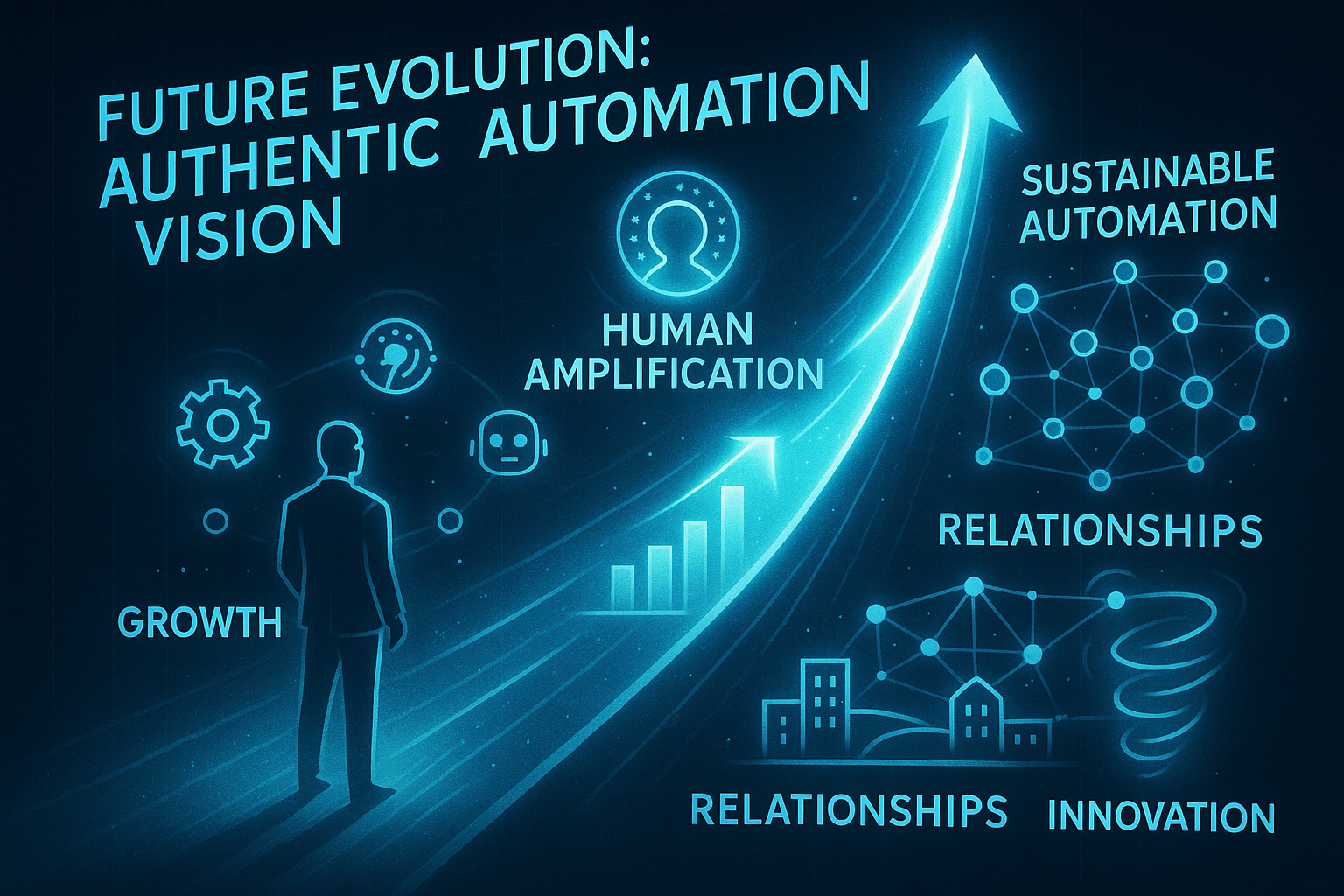
Your Next Steps
Here's what I want you to do today: start building your content repository. Begin documenting your unique expertise, stories, and frameworks. The brands that create authentic automation systems now will dominate their markets while others struggle with trust erosion from generic AI content.
Remember the AMPLIFY method: Archive your expertise, Maintain your voice, Personalize at scale, Leverage strategic systems, Integrate human oversight, Focus on relationships, Yield measurable trust. This research-backed approach delivers proven results while building sustainable competitive advantages.
The content marketing automation revolution is here, but it's not about replacing human expertise - it's about amplifying it. The companies that understand this distinction will thrive. The ones that don't will find themselves lost in a sea of generic AI slop, wondering why their audience stopped paying attention.
Your expertise, your stories, your unique perspective - these are your competitive advantages in an AI world. Automation should make them scale, not disappear. Let's make sure you're building trust, not eroding it.
Thanks for sticking with me through this deep dive. If you want to turn your marketing team into an AI-first marketing machine while maintaining authenticity, I'd love to help. Feel free to reach out, and let's get your team moving forward with content automation that actually builds the relationships your business depends on.
---
Related Articles

AI Content Marketing in 2025: What's Actually Working (And What's Just Hype)
Discover what's really working in AI content marketing in 2025. With 80%+ adoption rates and $7.65 ROI per dollar spent, learn the strategies backed by data and real case studies that separate success from hype.

How to Use AI for SEO Research: A Practical, Implementation Guide
Learn how to leverage AI agents and MCP servers for efficient SEO research and content optimization in this step-by-step guide with real automation workflows.
Stop destroying your brand with AI slop that gets penalized
Most agencies are stuck choosing between hiring expensive writers or pumping out generic AI content that kills credibility and tanks SEO rankings. But there's a third option. I've spent 8 years analyzing over 1,000 sales funnels at ClickFunnels and discovered how top companies scale content that actually builds trust—content that passes AI detection and ranks on Google. Watch this free walkthrough where I reveal the exact AMPLIFY Framework we use to help agencies create authentic content automation systems.
Watch the full breakdown now—no opt-in required.
Watch the Video →